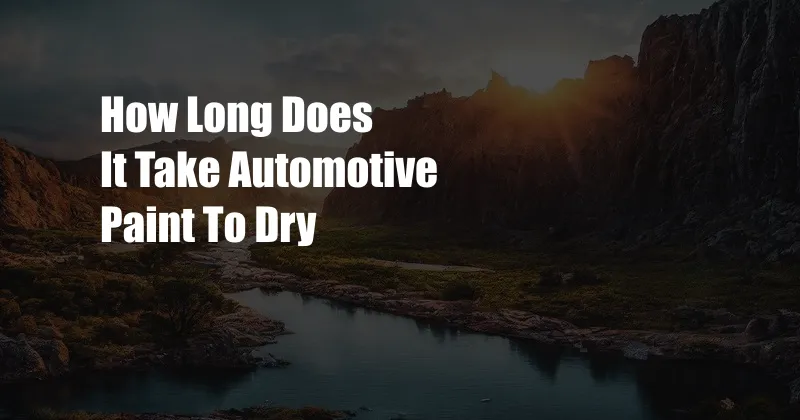
How Long Does it Take Automotive Paint to Dry?
As my old Toyota truck emerged from the paint booth, I couldn’t resist a quick touch. A vibrant shade of emerald green glistened under the studio lights, but the wet surface left a smudge on my fingertips. Impatience gnawed at me as I wondered, “How long will it take for this new paint to dry?”
Curing Time: A Critical Factor
The drying time of automotive paint is not simply a matter of waiting for it to feel dry to the touch. Two distinct stages determine the paint’s readiness:
- Flash Time: The initial stage where solvents in the paint evaporate, allowing the surface to dry quickly.
- Curing Time: A gradual process where chemical reactions within the paint strengthen the film and reach optimal hardness.
Factors Influencing Drying Time
Numerous factors influence the drying time of automotive paint:
- Paint Type: Different paint types, such as acrylic urethane or waterborne paint, have varying drying times.
- Temperature: Warmer temperatures accelerate evaporation and curing.
- Humidity: High humidity slows down evaporation, prolonging drying time.
- Film Thickness: Thicker paint films take longer to dry.
- Airflow: Proper airflow ensures even evaporation and reduces drying time.
Drying Times
Depending on the conditions, the following approximate drying times can be expected:
- Flash Time: Typically 15-30 minutes
- Initial Touch Dry: 2-4 hours
- Light Sanding: 6-8 hours
- Full Cure: 24-48 hours
Expert Tips for Faster Drying
- Use a Heat Lamp: Strategic placement of a heat lamp can increase the temperature and facilitate faster evaporation.
- Ventilate the Area: Open windows or use a fan to promote airflow and remove moisture.
- Apply Multiple Thin Coats: Instead of a thick single coat, opt for multiple thin coats to reduce drying time.
- Consider UV Lights: Ultraviolet lamps emit energy that can accelerate the curing process.
- Avoid Dust and Contaminants: Keep the painted area clean to prevent dust or debris from adhering to the wet paint.
Frequently Asked Questions
- Can I drive my car after the flash time? No, wait for at least 2-4 hours for initial touch dryness before driving.
- When can I wash my car after painting? Allow a minimum of 48 hours for full curing before washing.
- How long does it take for paint to completely harden? It takes several weeks for paint to reach its maximum hardness.
- Why does my paint look dull after drying? This is likely due to oxidation; use a car polish to restore shine.
- Can I speed up the curing process? Yes, by using heat lamps or UV lights, but follow recommended guidelines to avoid compromising the paint’s integrity.
Conclusion
Automotive paint drying time is a crucial aspect of a successful paint job. Understanding the factors that influence drying and following expert tips can ensure a faster and better result. While patience is key, don’t hesitate to consult with professionals if you encounter any challenges.
Are you curious about other aspects of automotive paint? Would you like to learn more about different paint types, advanced techniques, or maintenance tips?